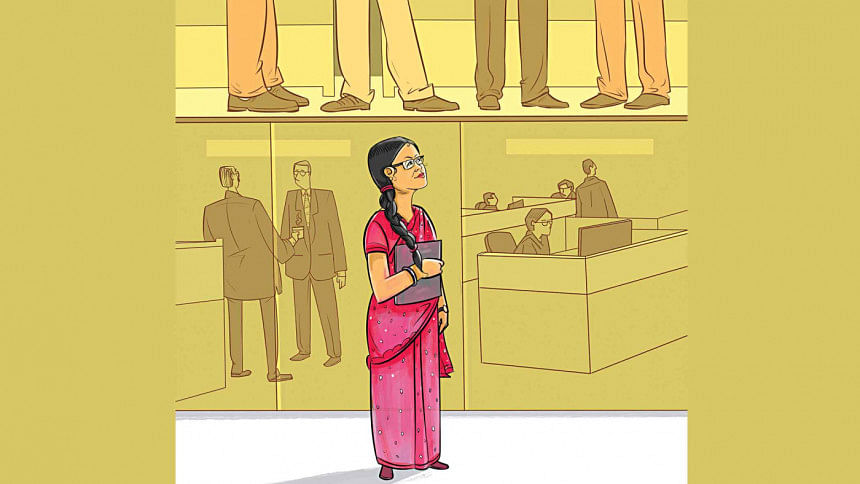Looking in, through the glass

But being denied an attainable dream, simply for your gender, or some prejudice enshrined in cultural heritage and traditions, can often feel terribly unfair and discouraging. One common manifestation of this phenomena can be termed as the glass ceiling, an amalgamation of the invisible and irrational barriers to women's growth in the work place.
A simple glance at the top management positions in various companies reveals the unbalanced gender ratios, even in mid managerial positions, and the scarcity of females in leadership roles is plain to see. According to an ILO report from 2015, women held only 5.4 percent of leading positions in the surveyed organisations.
This phenomenon actually manifests not just at the top, rather right from recruitment of fresh graduates, where female applicants are either overlooked despite better performance, and asked impertinent questions like whether they plan to get married soon, or they plan to have a child soon, or are they even serious about pursuing the jobs in the long term as "family responsibilities" will spring up. This attitude against the female employee, or the perceived inefficiencies even before they join, persist throughout their working lives, and is reflected in the salaries that women get. According to the ILO, the estimated global gender pay gap ranges between 16-22 percent in 2018/19.
"One of my recruitment interview questions was whether I was going to get married in the next couple of years, blatantly adding that if I were, it would make me a bad investment decision," a private sector employee said. These perceptions of low efficiency or lack of seriousness toward work also impede women's ability to command fair salaries. Research by Grout, Park & Sonderegger reveals that the glass ceiling can manifest in various ways, including women working harder at similar jobs to justify their worth, lower average salaries for women in the same jobs. Things like being questioned or judged for being ambitious in their careers, and being forced to work under less skilled supervisors are also common issues women face. On the home front, larger proportion of child and elderly care duties, a significantly larger share of household chores, and the mental fatigue of making all household decisions day in and day out, are challenges common to most working women.
"These prejudices won't be overtly reflected in policies, as policies are now often standardized, but you'll see the proportion of women is critically low, more so in the non-typical female functions like anything except HR or customer services," said a mid-level female professional at a leading mobile operator in the country.
"And when you look at senior management levels, the number of women falls drastically, as after same time commitments and effort levels, women just don't get promoted, get frustrated and move elsewhere," she added. Some companies do take tokenistic initiatives to decrease the gender disparities, but these rarely have any real effects, and often the inherent problems of gender-based performance assessments," she said.
"At my last company, my supervisor was given the senior role despite being visibly incompetent, and even though I had five years of experience in the same function over them. All my suggestions were brushed off, and warnings unheeded. The scene somewhat changed when a very public work-related blunder by the supervisor could no longer be covered up," said a mid-level female worker at a well-known NGO. She then left for greener pastures, with a better pay and promotion.
In the public sector, promotions and salaries are more or less structured, so the gender pay gap does not exist, neither does the glass ceiling per se. But in terms of preferential treatment, men get easier access to various opportunities that helps to prove a worker's calibre, like challenging postings. Also, in terms of symposiums and such, men get preferential treatment for being "more available for field work," even if women show interest or good capabilities, said a mid-level employee of a government bank. "I feel that some women themselves also have confidence issues, or may misuse the leniency granted for their gender, by not taking up challenges," she added. This also creates a problem for those who do want to work and excel.
"I was chastised for talking too much at meetings at my last work place, the complainant specifically said why did I need to talk so much being a woman, and that I should remember my place when the guys are talking," a female journalist said, she was at the time, working as the team leader of that function.
In Bangladesh's best celebrated industry, the RMG sector, which is often lauded for created a paradigm shift in female emancipation through jobs for low skilled women, there are very few women in supervisory positions. On the other hand, women globally still account for just 12 percent of the boards of the largest companies.
It appears the ceiling is not just a barrier to the top, rather, it exists for practically all women, regardless of their current position in the hierarchy. But perhaps that is why women at large are increasingly becoming more and more intent on breaking these barriers, and through the ages, that is how pioneering women in every field have shattered these walls, rising to heights of success and glory.
Creatives: Biplob Chakrabarty

 For all latest news, follow The Daily Star's Google News channel.
For all latest news, follow The Daily Star's Google News channel. 



Comments